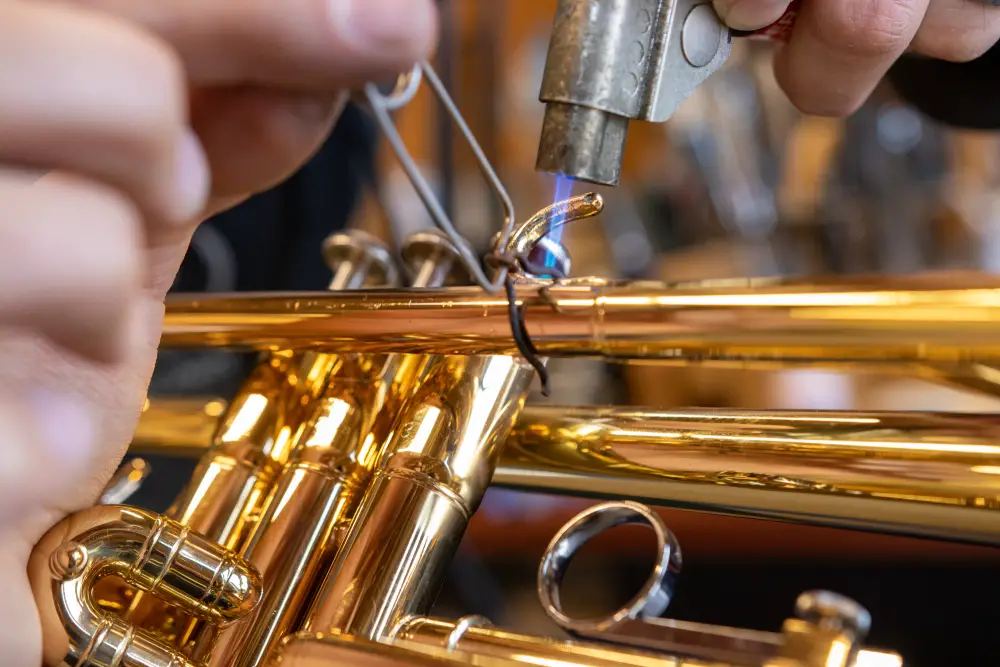Brass is an alloy of copper and zinc, making it easy for the solder to adhere to materials made from this metal. Tubings and fittings made from brass are soldered using lead/tin solder just as household plumbing. The fittings are molded using slip joints so you can quickly connect them to pipes. Here’s a guide on how to solder brass fittings:
Materials Required
- Flux
- Solder
- Tweezers
- Metal file
- Brass pieces
- Abrasive pad or 120-grit sandpaper
- Soldering iron
Procedure
Choose an Appropriate Solder for the Project
Given the different types of solder, you need to choose the right one for soldering brass fittings. Soft solder is ideal as it has a low melting point. It is also preferred because high temperatures cause brass materials to become soft and discolor, a process called annealing.
Prepare the Workspace
You need to have a safe workspace for the process. As such, you need to remove any flammable materials from the surface and keep the space well-ventilated. A small fan may come in handy to blow the fumes away. You may also create a barrier for the flame using two fire bricks, which also function as reflectors that bounce the heat from the torch.
Inspect the Pieces and Clean Them
Check whether the brass pieces fit together. If not, they may need reshaping using a file or a cutting tool to ensure the parts fit together. Then, hold them up a few inches from the light source to see if there are gaps between the pieces. Then clean the pieces using an abrasive pad or 120-grit sandpaper. Proper preparation of the pipe ensures the solder adheres to the surface firmly.
Clamp the Pieces
Hold the pieces using a clamp as they will become hot as you continue using the soldering iron. You may also use heavy metallic objects to hold the objects as long as you avoid placing them too close to the joint.
Apply Flux
Apply flux on the outer part of the pipe and insider the brass fitting too using a small brush. Alternatively, use a thin wire to apply flux as the brush may spread too much flux. Then, slide the fitting onto the pipe and rotate it to the correct orientation.
Soldering the Fittings
Start heating the joint using a propane torch until the flux reaches the boiling point. Since it is difficult to attain the same temperature at the same time, you should make sure the time spent at each piece is the same as its mass. For example, if soldering a thick piece of metal, you are likely to spend more time than if heating thin tubing.
Once the parts reach the ideal temperature, the flux will produce smoke and turn black. Remove the source of heat and quickly apply solder around the pipe as it seeps into the joint. This is because the metal only remains hot enough to melt the solder for a few seconds.
Then, solder the other joint as soon as the first joint solidifies and allows the fitting to cool for 10-20 minutes before touching it. Next, rinse the fitting under running water to rid of excess flux. Dry it and clean excess solder.
Additional Tips
- Ensure the parts fit together: Solder is only a bonding agent. As such, you should ensure the pieces getting joined fit together correctly. They should have the same surface area to allow the solder to join them successfully. The solder will not be as strong if the pieces have gaps in between them
- Clean the parts before soldering: The strength of the bond depends on the condition of the surfaces. Dirt has impurities that affect the strength of the bond. As such, you need to clean the parts thoroughly before soldering the pieces
- Heat the pieces, not the solder: While the process involves using solder to join parts, it does not mean soldering the bonding agent. Instead, the parts are heated until they have attained the melting point of the solder. The solder should flows to the heated object and into its seams through capillary action
- Hold the parts firmly when soldering: Ensure the parts are held firmly when soldering, so the solder forms a strong bond


